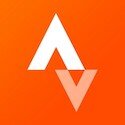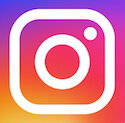BCI no longer prints route slips; riders need to print up your own route slips
(links to printable .pdf are available at each ride description)
Most were set up in the “before times” to be printed & cut in half; they have 2 slips per page, and all 3 routes in one 3 page .pdf file. Newer ones may be set up to fold in half, allowing larger fonts & readability.
Just print the page(s) you want, and fold (or cut in half to share with others if duplicates...)
Tuesdays have different 30 & 25 routes side by side on one page to fold.
Some remotes may or may not have the 2-per-page formats.
If you do not have a printer, get a friend to bring an extra copy for you.
Note - RideWithGPS does generate a cue sheet for each route,
but the BCI Route Slip is most accurate and designed to fit on 1/2 page slip to clip to your handlebar… Print the BCI route slips!
Folks may be curious or wonder what the odd turns are that are listed on BCI’s
Route Slips / “Cue Sheets”. This glossary will translate those cryptic cues:
L, R & to are obvious (L = LEFT R = RIGHT to = Continue to / name change etc)
but here are some other cues you may see:
°L = CIRCLE LEFT - You are going most of the way around a ‘round-a-bout’ or traffic circle, effectively ending up going left around the circle 3/4 or 7/8 of the way. (See details about round-a-bouts below)
°R = CIRCLE RIGHT - You are going to enter a circle and exit 1/4 way around, effectively just going right at teh first opportunity.
⌘L = CLOVERLEAF LEFT ⌘R = CLOVERLEAF RIGHT - You are going to making a loop around & under or over your current direction - think of the Bayside sidepath looping onto the San Diego Creek path under Jamboree at the top of Newport Bay…
*L = LEFT TURN - Reminder to consider Box Turn option
- calls out high stress intersections where, depending on traffic and timing, a usual merge over to the left turn only lane may be a challenge - instead you can usually do a ‘double cross’ and proceed across & then go left from the far corner, front of through travel lane or a painted 2-stage left-turn queue box
FR = FORCED RIGHT FL = FORCED LEFT
- the road ends, turn right or left at the corner where there is no other choice but the street name changes
#R = SHARP RIGHT #L = SHARP LEFT
- Sometimes we take a connection to a bike path, and make a hard turn (more acute than 90°) to take the path under the adjacent street
BR = BEAR RIGHT BL = BEAR LEFT
= At a “Y” or when we exit a bike path, or stay on a bike path we might take a slight turn to one side or the other. RideWithGPS calls these “Slight Right” or “Slight Left”
JR = JOG RIGHT JL = JOG LEFT
Continue in the same direction, but perhaps go from an adjacent / parallel road to a side path, or sidewalk onto street, or main street to it’s frontage road…
L Jeffrey Open Space (path)
JL JEFFREY
BR = KEEP RIGHT BL = KEEP LEFT
= Choose when path splits - sometimes the road diverges and we need to keep to the left to get clear of a right turn freeway entrance or free right turn, or the road had a point where we want to keep right and go straight rather than follow the curve left…
U = U-Turn
- Make a 180° reversal, usually just like typical road traffic, or at a dead end, or back out of a coffee stop
X = Cross
- Notes a point where the route crosses a significant road or freeway, maybe with name change. Especially helpful if you cross the road once then loop back and turn on it the second time… the crossed street is in CAPITALS, but may be Italicized and not BOLD because it’s a landmark, not a turn ie:
L TECHNOLOGY
X ALTON (1st time)
R ALTON (2nd time)
Unique Descriptions:
Street names are sometimes shown with 2 arrows: ie
<FAWN GLEN / DEER SPRING>
- That means the street signs may have different names when the cross street changes.
In example, Fawn Glen to the North and Deer Spring to the south… If you only see Fawn Glen you might miss the turn onto Deer Spring.
If you are turning right, the format is <FAWN GLEN / DEER SPRING>
If you are turning left, the format is <FAWN GLEN / DEER SPRING>
/ = Name Change (same as “to”)
A turn onto a street that continues with a name change might have 2 lines:
R CAMPUS /
to IRVINE
means turn right on Campus Drive and at some point it will change names to Irvine Ave
or the same situation may be shown on one line with “/” added ie:
CAMPUS / IRVINE or
EDINGER / ICD/ MOULTON / GOLDEN LANTERN or on 2 lines as:
ORCHARD HILLS /
CULVER or
TUSTIN RANCH /
VON KARMAN
- that shows the route continues on the same road but the road’s name changes.
There may be a cross street called out where the name changes:
R TUSTIN RANCH X EDINGER
to VON KARMAN
Bike Paths & Shared Use Paths
If the route goes off street onto a path you will see lowercase and not bold:
ie: ”Walnut Tr (bike path)” which distinguishes it from the “WALNUT” street.
If there is a wayfinding sign it will often call the bike path a “Trail” even if it is a path.
Usually STREETS are printed in ALL CAPITALS and BOLD
Cross STREETS are printed ALL CAPITALS & NOT bold
while named ‘bike paths’ are in LowerCase and not bold
Descriptions, details, notes are usually (italicized and/or in parentheses) ie:
ROYCE & MICHELSON (Bold Caps) are streets
UNIVERSITY (Italic Caps) is a road we cross
University Tr (Path) is a bike path so lower case
SAND CANYON has 2 lanes entering the round-a-bout with SHADY CANYON and QUAIL HILL, but you can stay in the #2 right lane to go ‘left’ 3/4 around the circle and do not have to merge left to the #1 lane… like we do at Laguna Canyon from Quail Hill eastbound (see below on Roundabouts).
Black Diamond ? No - a “CORNER”
Sometimes we cut up onto a corner curb cut to access a side path or bike path or get onto a sidewalk, or just get out of the road to make a 2- step box turn:
On most current route slips we have added an arrow at each line with a Left turn or unusual right turn…
Frequently we mark up a roundabout turn with a tiny fish hook arrow like on the sample above, or instead of just a L or °L, and often you will see “3/4 circle” or “2nd or 3rd exit” details. If the route stays on a street with a roundabout, and does not change name or turn onto an intersecting cross street, it may not even get mentioned, as you continue straight through the circle to stay on the same street.
If a 2 lane roundabout requires you to use the #1 left lane to go straight or circle left, the route slip might say “L Lane” or “#1 Lane” to tell you to merge over when required BEFORE the circle.
Bike Lanes always end before a round-a-bout so we should merge into the travel lanes before any roundabout. This is never a good place to edge ride, as motorists WILL pass you if you take the gutter position. When you merge into the travel lane(s) you should do so sooner as traffic allows, not at the last moment when the bike lane ends. Roundabouts are supposed to have a place to exit and use the sidewalk and crosswalks around the circle as a pedestrian if you don’t want to take the lane and move like other traffic. If there is a bike lane, it will end where you can exit and become a sidewalk user.
Profiles are shown when we map out the routes on RideWithGPS.com. We can capture the profile, and add it to the route sheet. It gives a clue about how much the route climbs.
Some have the regroup coffee stop marked
Colors
Most route slips are just fine printed in B&W - Grayscale
(Save the color ink/toner) but some have light colored shading…
A Blue shading signifies riding on a sidewalk or side-path along the edge of a road.
A Pink shading signifies riding on a bike path or shared use ‘trail’
A Green shading signifies that you are following a posted bike route
A Grey shading is used when a route has different options, like the Tuesday short cuts















